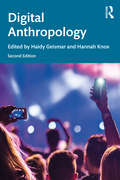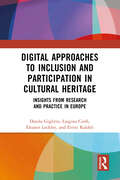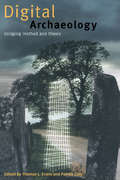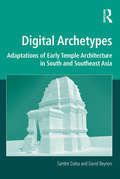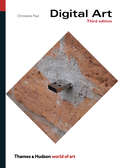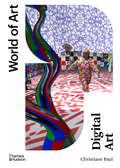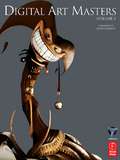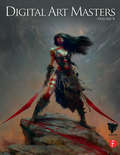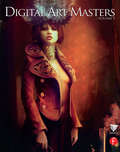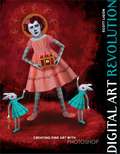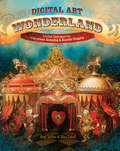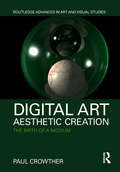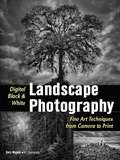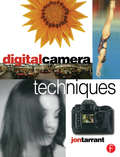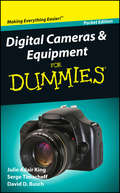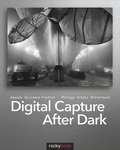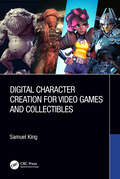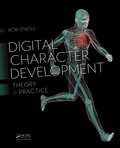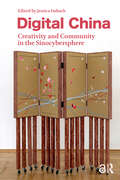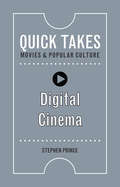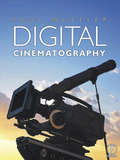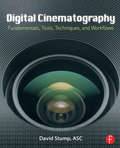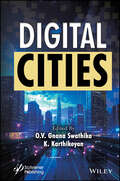- Table View
- List View
Digital Anatomy: Applications of Virtual, Mixed and Augmented Reality (Human–Computer Interaction Series)
by Joaquim Jorge Jean-François Uhl Daniel Simões Lopes Pedro F. CamposThis book offers readers fresh insights on applying Extended Reality to Digital Anatomy, a novel emerging discipline. Indeed, the way professors teach anatomy in classrooms is changing rapidly as novel technology-based approaches become ever more accessible. Recent studies show that Virtual (VR), Augmented (AR), and Mixed-Reality (MR) can improve both retention and learning outcomes. Readers will find relevant tutorials about three-dimensional reconstruction techniques to perform virtual dissections. Several chapters serve as practical manuals for students and trainers in anatomy to refresh or develop their Digital Anatomy skills. We developed this book as a support tool for collaborative efforts around Digital Anatomy, especially in distance learning, international and interdisciplinary contexts. We aim to leverage source material in this book to support new Digital Anatomy courses and syllabi in interdepartmental, interdisciplinary collaborations. Digital Anatomy – Applications of Virtual, Mixed and Augmented Reality provides a valuable tool to foster cross-disciplinary dialogues between anatomists, surgeons, radiologists, clinicians, computer scientists, course designers, and industry practitioners. It is the result of a multidisciplinary exercise and will undoubtedly catalyze new specialties and collaborative Master and Doctoral level courses world-wide. In this perspective, the UNESCO Chair in digital anatomy was created at the Paris Descartes University in 2015 (www.anatomieunesco.org). It aims to federate the education of anatomy around university partners from all over the world, wishing to use these new 3D modeling techniques of the human body.
Digital Anthropology
by Haidy Geismar; Hannah KnoxDigital Anthropology, 2nd Edition explores how human and digital can be explored in relation to one another within issues as diverse as social media use, virtual worlds, hacking, quantified self, blockchain, digital environmentalism and digital representation. The book challenges the prevailing moral universal of “the digital age” by exploring emergent anxieties about the global spread of new technological forms, the cultural qualities of digital experience, critically examining the intersection of the digital to new concepts and practices across a wide range of fields from design to politics. In this fully revised edition, Digital Anthropology reveals how the intense scrutiny of ethnography can overturn assumptions about the impact of digital culture and reveal its profound consequences for everyday life around the world. Combining case studies with theoretical discussion in an engaging style that conveys a passion for new frontiers of enquiry within anthropological study, this will be essential reading for students and scholars interested in theory of anthropology, media and information studies, communication studies and sociology. With a brand-new Introduction from editors Haidy Geismar and Hannah Knox, as well as an abridged version of the original Introduction by Heather Horst and Daniel Miller, in conjunction with new chapters on hacking and digitizing environments, amongst others, and fully revised chapters throughout, this will bring the field-defining overview of digital anthropology fully up to date.
Digital Approaches to Inclusion and Participation in Cultural Heritage: Insights from Research and Practice in Europe
by Luigina Ciolfi Danilo Giglitto Eleanor Lockley Eirini KaldeliDigital Approaches to Inclusion and Participation in Cultural Heritage brings together best examples and practices of digital and interactive approaches and platforms from a number of projects based in European countries to foster social inclusion and participation in heritage and culture. It engages with ongoing debates on the role of culture and heritage in contemporary society relating to inclusion and exclusion, openness, access, and bottom-up participation. The contributions address key themes such as the engagement of marginalised communities, the opening of debates and new interpretations around socially and historically contested heritages, and the way in which digital technologies may foster more inclusive cultural heritage practices. They will also showcase examples of work that can inspire reflection, further research, and also practice for readers such as practice-focused researchers in both HCI and design. Indeed, as well as consolidating the achievements of researchers, the contributions also represent concrete approaches to digital heritage innovation for social inclusion purposes. The book’s primary audience is academics, researchers, and students in the fields of cultural heritage, digital heritage, human-computer interaction, digital humanities, and digital media, as well as practitioners in the cultural sector.
Digital Archaeology: Bridging Method and Theory
by Patrick Daly Thomas L. EvansThe use of computers in archaeology is entering a new phase of unparalleled development, moving on from a specialist methodology on the margins to a powerful practical and analytical tool used across all areas of archaeological interest. With a thorough examination of the ways in which both everyday and cutting-edge technologies can be used to inform and enhance traditional methods, this book brings together ideology from the academic world and pragmatic, concrete examples to show how fieldwork, theory and technology fit together today as never before. Covering a history of the rise of computer use in archaeology as well as a thorough assessment of a number of high profile examples such as the Ferrybridge Chariot, this book shows how new technologies have been implemented into both theory and method as an integral part of the archaeological process. With contributions from renowned experts, experienced professionals and emerging names in the field, this unique, forward-thinking book brings together previously disparate aspects of archaeology in a new holistic approach to the study of the past. A companion website is also available to allow further study of the images included.
Digital Archetypes: Adaptations of Early Temple Architecture in South and Southeast Asia (Digital Research in the Arts and Humanities)
by Sambit Datta David BeynonThis unique book presents a broad multi-disciplinary examination of early temple architecture in Asia, written by two experts in digital reconstruction and the history and theory of Asian architecture. The authors examine the archetypes of Early Brahmanic, Hindu and Buddhist temple architecture from their origins in north western India to their subsequent spread and adaptation eastwards into Southeast Asia. While the epic monuments of Asia are well known, much less is known about the connections between their building traditions, especially the common themes and mutual influences in the early architecture of Java, Cambodia and Champa. While others have made significant historiographic connections between these temple building traditions, this book unravels, for the first time, the specifically compositional and architectural linkages along the trading routes of South and Southeast Asia. Through digital reconstruction and recovery of three dimensional temple forms, the authors have developed a digital dataset of early Indian antecedents, tested new technologies for the acquisition of built heritage and developed new methods for comparative analysis of built form geometry. Overall the book presents a novel approach to the study of heritage and representation within the framework of emerging digital techniques and methods.
Digital Art (Third edition) (World of Art)
by Christiane Paul"Paul does an impressive job of compressing the activity of a huge field, in which there are no obvious heroes and no single aesthetic line." --Publishers Weekly Digital technology has revolutionized the way we produce and experience art today. Not only have traditional forms of art such as printing, painting, photography, and sculpture been transformed by digital techniques and media, but the emergence of entirely new forms such as internet and software art, digital installation, and virtual reality has forever changed the way we define art. Christiane Paul surveys the developments in digital art from its appearance in the 1980s to the present day and looks ahead to what the future may hold. She discusses the key artists and works in the genre, drawing a distinction between work that uses digital practices as tools to produce traditional forms and work that uses them to create new kinds of art. She explores the broader themes and questions raised by these artworks such as viewer interaction, artificial life and intelligence, political and social activism, networks and telepresence, and issues surrounding the collection, presentation, and preservation of digital art. This third, expanded edition of the popular resource investigates key areas of digital art practice that have gained prominence in recent years, including interactive public installation, augmented and mixed reality, social networking, and file-sharing technologies.
Digital Art (World of Art #0)
by Christiane PaulThe fourth edition of the essential introduction to digital art, one of contemporary art’s most exciting and dynamic forms of practice. Digital art, along with the technological developments of its medium, has rapidly evolved from the “digital revolution” into the social media era and then to the postdigital and post-Internet landscape. This new, expanded edition of Christiane Paul’s acclaimed book traces the emergence of artificial intelligence, augmented and mixed realities, and non-fungible tokens (NFTs) and surveys themes explored by digital artworks in the areas of activism, networks and telepresence, and ecological art andthe Anthropocene. It also examines issues surrounding the collection, presentation, and preservation of digital art. It looks at the impact of digital techniques and media on traditional forms of art, such as printing, painting, photography, and sculpture, as well as exploring the ways in which the Internet and software art, digital installation, and virtual reality have emerged as recognized artistic practices. Digital Art is an accessible and engaging text that brings to life individual works, explaining in clear terms how they use technologyto produce artworks with a radical new aesthetic and thematic and interactive qualities. It is an essential critical guide to all forms of digital art.
Digital Art Masters: Volume 2
by 3dtotal.ComMeet some of the finest digital 2D and 3D artists working in the industry today, from Patrick Beaulieu, Philip Straub, Benita Winckler, Alessandro Baldasseroni to Khalid Al Muharraqi, Marcel Baumann and Marek Denko and see how they work. More than just a gallery book - in Digital Arts Masters each artist has written a breakdown overview, with supporting imagery of how they made there piece of work.With Digital Arts Masters you'll understand the artists' thought process and discover the tips, tricks and techniques which really work.
Digital Art Masters: Volume 4 (Digital Art Masters Series)
by 3dtotal.ComMeet some of the finest 2D and 3D artists working in the industry today and discover how they create some of the most innovative digital art in the world. More than a gallery book or a coffee table book- Digital Art Masters Volume 4 includes over 50 artists and 900 unique and stunning 2D and 3D digital art. Beyond the breaktaking images is a breakdown of the techniques, challenges and tricks the artists employed while creating stunning imagery. This volume, much like the previous volumes is not your standard coffee table book nor is it our usual how-to-book. This book offers inspiration and insight for the advanced amateur and professional CG artists. The Digital Art Masters series has expanded upon the competition's gallery book concept and has added the insight and experiences of professional CG artists worldwide. Divided into 5 sections, Sci-Fi, Scene, Fantasy, Character and Cartoon, Each featured artist segement will include the thought processes behind creating unique digital images and an artist portfolio for further inspiration. Find your inspiration and discover the tips, tricks and techniques that really work.
Digital Art Masters: Volume 5
by 3dtotal.ComMeet some of the finest 2D and 3D artists working in the industry today and discover how they create some of the most innovative digital art in the world. More than a gallery book or a coffee table book- Digital Art Masters Volume 5 includes over 50 artists and 900 unique and stunning 2D and 3D digital art. Beyond the breath taking images is a breakdown of the techniques, challenges and tricks the artists employed while creating stunning imagery. This volume, much like the previous volumes is not your standard coffee table book nor is it our usual how-to-book. New to this volume will be 5 artist video tutorials. Five artists will specifically detail an aspect of their gallery image from start to finish, offering further technique driven insight and expertise offering 2 ½ hours of additional inspiration. With a click of a mouse, artists willbe able to apply the leading techniques to their own work with access to additional video tutorials, source files, textures and digital brushes at the companion website: http://www.focalpress.com/digital-art-masters/index.html.
Digital Art Revolution
by Scott LigonThere's no question that applications like Photoshop have changed the art world forever. Master digital artists already use these tools to create masterpieces that stretch the limits of the imagination--but you don't have to be a master to create your own digital art. Whether you're a beginner who's never picked up a pen or paintbrush, or a traditional artist who wants to explore everything a digital canvas might inspire, digital artist and arts educator Scott Ligon guides you and inspires you with clear instructions and exercises that explore all the visual and technical possibilities.Featuring the work of 40 of the finest digital artists working today, Digital Art Revolution is your primary resource for creating amazing artwork using your computer.From the Trade Paperback edition.
Digital Art Wonderland: Creative Techniques for Inspirational Journaling and Beautiful Blogging
by Angi Sullins Silas ToballSet out on a digital adventure! Come inside Digital Art Wonderland where digital art and art journaling embark together on a luscious visual journey. The daring crew of Angi Sullins and Silas Toball give you a personal tour through a digital art journaling world, showing you how to make your own wonderous creations through instruction, design concepts and lots of inspiration. In Digital Art Wonderland, you'll find: 8 tutorials with techniques, tricks and trips for the intermediate Adobe Photoshop user to enhance physical art as well as create digital art from scratch. Instructions and ideas to incorporate a variety of typography into your artwork. A guide to using your art in the blogging world, including information about blog set-up, adding personal design touches, blog etiquette and more. Exercises for breaking free of art-making fears and letting your artistic instincts take over. Let Digital Art Wonderland show you a whole new world of art making.
Digital Art and Meaning: Reading Kinetic Poetry, Text Machines, Mapping Art, and Interactive Installations (Electronic Mediations)
by Roberto SimanowskiIn a world increasingly dominated by the digital, the critical response to digital art generally ranges from hype to counterhype. Popular writing about specific artworks seldom goes beyond promoting a given piece and explaining how it operates, while scholars and critics remain unsure about how to interpret and evaluate them. This is where Roberto Simanowski intervenes, demonstrating how such critical work can be done. Digital Art and Meaning offers close readings of varied examples from genres of digital art such as kinetic concrete poetry, computer-generated text, interactive installation, mapping art, and information sculpture. For instance, Simanowski deciphers the complex meaning of words that not only form an image on a screen but also react to the viewer&’s behavior; images that are progressively destroyed by the human gaze; text machines generating nonsense sentences out of a Kafka story; and a light show above Mexico City&’s historic square, created by Internet users all over the world. Simanowski combines these illuminating explanations with a theoretical discussion that employs art philosophy and history to achieve a deeper understanding of each particular example of digital art and, ultimately, of the genre as a whole.
Digital Art, Aesthetic Creation: The Birth of a Medium (Routledge Advances in Art and Visual Studies)
by Paul CrowtherIs art created with computers really art? This book answers ‘yes.’ Computers can generate visual art with unique aesthetic effects based on innovations in computer technology and a Postmodern naturalization of technology wherein technology becomes something we live in as well as use. The present study establishes these claims by looking at digital art’s historical emergence from the 1960s to the start of the present century. Paul Crowther, using a philosophical approach to art history, considers the first steps towards digital graphics, their development in terms of three-dimensional abstraction and figuration, and then the complexities of their interactive formats.
Digital Black & White Landscape Photography
by Gary WagnerLandscape photography is a popular photographic genre--and for good reason. The great outdoors is an ever-ready subject. It is variable, as well; it is affected by changing light, decomposition, weather, human interaction, and myriad other factors. Its features range from natural to manmade elements--and many landscapes are comprised of both. Photographers who point their camera's lens at a scene do so in an effort to communicate their feelings about the landscape. Rather than simply document the scene, they seek to capture the spirit of place--perhaps to tell a story or depict a mood. They aim to share with viewers the ways in which the scene speaks to them. Accomplishing these goals may seem simple at the outset, but the task is rife with challenges. In this book, Gary Wagner shows readers how to create powerful, evocative black & white landscape photographs filled with beautiful light, a full range of tones, and exquisite detail. Beginning with a look at the gear you'll need to get the best-possible images, Wagner covers cameras, lens types, tripods, and filters. He then discusses the postproduction processes he uses to enhance his images, producing breathtaking photographic records of natural and man-altered locales. Following a run-through of the basic tenets of landscape photography, Wagner presents 60 of his favorite images for review. Readers will find images in six categories: (1) Lakes and Streams, (2) Trees and Rocks, (3) Coastal Seascapes, (4) Winter, and (5) Man-Altered Landscapes. This presentation model allows readers to focus on the aspects of landscape photography that most appeal to them or challenge them most. With each image presented, readers will learn the strategies that went into conceptualizing and creating the shot--from exposure, to composition, to postproduction, and more. With information on every aspect of creating striking, moving landscape images--from choosing gear, to studying light, to calculating ideal exposures, to composing images, to retouching/manipulating the images for breathtaking results, to setting up your workflow to ensure that the printed/output image meets the strictest criteria, this book will prove indispensable to photographers new to landscape photography or those seeking to take their image creation to a whole new level.
Digital Camera Techniques
by Jon TarrantThe best photographs start with proper attention behind the camera before you take them. Jon Tarrant shows you how to achieve this by fully explaining how digital cameras work so you too can achieve professional-looking results without having to resort to image manipulation on a computer. Jon explains all the basics of digital cameras: their anatomy; an outline of broad classes, indicated by price bands and features offered; a comparison with existing families of film cameras as a useful guide to newcomers. He also provides an invaluable buyer's guide pointing out features to look for on a digital camera before you make your purchase.Coverage includes detail on lenses, exposure basics, 'correct' exposure, using flash, the chip and the implications of this 'restriction', image quality and retaining this quality, as well as discussion of the difficulties of digital cameras and sections on specific types of photography with digital cameras. Complete coverage is ensured with information on printing, storage and filing, the Internet as a medium of images, picture software and digital enhancement, always keeping the emphasis on the fact that the most important consideration is how you take the photographs and the vision you had then and knowing when to stop tinkering with your image!This inspirational, full colour guide is what all digital camera owners have been waiting for. Jon Tarrant shows all keen digital photographers how to improve their photography and make the most of the latest technology.
Digital Cameras and Equipment For Dummies, Pocket Edition
by Julie Adair King Serge Timacheff David D. BuschHow to choose, use, equip, and maintain your digital camera Which digital camera best suits your needs? How many megapixels do you really need? How do you store and protect your photos? Which features areessential and which are expensive frills? Find the answers for buying, using, and caring for your digital camera in this little book! Open the book and find: How to choose between point-and-shoot and SLR Money-saving shopping pointers Insight on the best photo editing software Advice on memory cards and storage Camera maintenance and emergency care tips
Digital Capture After Dark
by Amanda Quintenz-Fiedler Philipp Scholz RittermannThe pitfalls of photographing at night are many. Autofocus and built-in light meters generally fail at night. Long exposures tend to make noisy or blurry photographs. Cameras set to automatic generally trigger the built-in flash in low light conditions, which results in unsatisfying images. Lack of understanding and inappropriate techniques often ruin the dramatic potential of nighttime images. In Digital Capture After Dark you will learn to overcome these and other obstacles. You will go beyond the many "how-to's" of capturing digital images at night to the "why-to's" of long exposure photography; including the importance of how we think and see at night compared to during the day. Also discussed are hands-on image editing techniques that will help you prepare your images for output. Detailed descriptions cover color balancing, expanding dynamic range, controlling flare, dealing with noise, converting to black-and-white, toning, and much more.
Digital Character Creation for Video Games and Collectibles
by Samuel KingThis book covers the process of creating digital characters for video games as well as for 3D printing and collectibles. It looks at character asset creation for high-end AAA console games as well as asset creation for legacy devices and the ever-growing mobile gaming industry. Lastly, it covers creation of figurines for 3D printing and collectibles. Digital Character Creation for Video Games and Collectibles provides a step-by-step walkthrough of creating these assets at an industry level standard. It includes the necessary theory that you need to understand how to be an effective character artist, but primarily focuses on the practical skills needed for creating character assets in the modern games and collectibles industries. This book will be of great interest to all beginners and junior character artists currently working in the gaming or collectible industry and for those looking to enter these industries. There is also relevant content in the highly detailed examples for people currently working in the industry and looking to pick up a few new tips, tricks and knowledge.
Digital Character Development: Theory and Practice, Second Edition
by Rob O'NeillEvery animated film and video game production spends a large percentage of its resources and time on advancing the quality of the digital characters inhabiting the world being created. This book presents the theory and practice behind the creation of digital characters for film and games using software-agnostic descriptions that apply to any animation application. It provides insight from a real production environment and the requirements that such an environment imposes. With rich illustrations and visual code examples throughout, this book provides a comprehensive roadmap to character development for both professionals and students.
Digital China: Creativity and Community in the Sinocybersphere
by Jessica ImbachOver the past decade, digital technologies have profoundly reshaped the Chinese cultural landscape. With a focus on the creative agency of new media and online communities, this volume examines this development through the notion of the Sinocybersphere - the networked spaces across the globe that not only operate on the Chinese script, but also imaginatively negotiate the meanings of Chinese culture in the digital age. Instead of asking what makes the internet or new media “Chinese,” the chapters situate contemporary entanglements of cultural and digital practices within specific historical, social, and discursive contexts. Covering topics as diverse as live-streaming, AI poetry, online literature, poetry memes, cyberpunk fiction, virtual art exhibitions, cooking videos, censorship, and viral translations, the collection as a whole not only engages with a wide range of Chinese new media phenomena, but also demonstrates their relevance to our understanding of contemporary digital culture.
Digital Cinema: The Seduction Of Reality (Quick Takes: Movies and Popular Culture)
by Stephen PrinceDigital Cinema considers how new technologies have revolutionized the medium, while investigating the continuities that might remain from filmmaking’s analog era. In the process, it raises provocative questions about the status of realism in a pixel-generated digital medium whose scenes often defy the laws of physics. It also considers what these changes might bode for the future of cinema. How will digital works be preserved and shared? And will the emergence of virtual reality finally consign cinema to obsolescence? Stephen Prince offers a clear, concise account of how digital cinema both extends longstanding traditions of filmmaking and challenges some fundamental assumptions about film. It is essential reading for anyone interested in understanding how movies are shot, produced, distributed, and consumed in the twenty-first century.
Digital Cinematography
by Paul WheelerHigh end digital cinematography can truly challenge the film camera in many of the technical, artistic and emotional aspects of what we think of as 'cinematography'. This book is a guide for practising and aspiring cinematographers and DOPs to digital cinematography essentials - from how to use the cameras to the rapidly emerging world of High Definition cinematography and 24p technology. This book covers the `on-the-set' knowledge you need to know - its emphasis lies in practical application, rather than descriptions of technologies, so that in this book you will find usable `tools' and information to help you get the job done. From `getting the look' to lighting styles and ratios, what is needed for different types of shoots and the technical preparation required, this is a complete reference to the knowledge and skills required to shoot high end digital films. The book also features a guide to the Sony DVW in-camera menus - showing how to set them up and how they work - adevice to save you time and frustration on set. Paul Wheeler is a renowned cinematographer/director of photography and trainer, he runs courses on Digital Cinematography at the National Film & Television School and has lectured on the Royal College of Art's MA course and at The London International Film School. He has been twice nominated by BAFTA for a Best Cinematography award and also twice been the winner of the INDIE award for Best Digital Cinematography.
Digital Cinematography: Fundamentals, Tools, Techniques, and Workflows
by David StumpFirst published in 2014. Routledge is an imprint of Taylor & Francis, an informa company.

